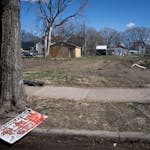Dozens of cyclists converged on the Capri Theater in north Minneapolis last month to hoist a few beers, nibble on healthy appetizers and chat about their shared love of two-wheeled transportation.
Part of a national coalition of advocates called PeopleForBikes, the evening focused on what people of color experience while biking in the Twin Cities, which is nationally known for its extensive network of trails and pathways.
It proved to be a timely topic, as the city explores adding a new bike and pedestrian greenway in the heart of the North Side. While a recent study found most residents along the five-block stretch of Irving Avenue N. want some fashion of greenway, others worry the trendy infrastructure could promote gentrification in one of the few remaining affordable neighborhoods in the metro.
"Longtime community members will see bike lanes, and say, 'Oh that's for middle-class hipster white people to use,' " said Melody Hoffmann, a bike advocate who wrote a book, "Bike Lanes Are White Lanes: Bicycle Advocacy and Urban Planning." "That's what they see in other places in town, when that's not necessarily the dominant group of cyclists."
The fear is that coveted bike paths could play a role in increasing property values and rents, pushing out long-standing residents. But, as Hoffmann notes, bike paths "are just one tool in the gentrification toolbox."
The yearlong North Minneapolis Greenway experiment did not directly address gentrification fears, but they were an undercurrent among many residents in the quiet neighborhood between Folwell Park and Jordan Park.
Mostly, the conversion of city streets into public spaces with no cars or limited traffic elicited concerns about parking, as well as access for people with mobility issues and emergency and police vehicles.
The study "showed that there's a lot of support [for] a greenway concept, but also a lot questions and concerns on how it would [be] implemented," said Sarah Stewart, active living coordinator for the Minneapolis Health Department. "These are things that were hard to answer without trying the concept."
Irving Avenue trial
Six years ago, city officials began mulling ways to convert low-traffic streets in north Minneapolis into greenway, and the Irving Avenue stretch fit the bill.
Creating this kind of bike and pedestrian infrastructure from an existing street is unusual. The widely heralded Midtown Greenway, which cuts across south Minneapolis, was built along a railroad corridor — a common model used nationally for bike trails. The greenway is now rimmed by glassy apartment buildings, particularly in the Uptown and LynLake neighborhoods.
In other cases, streets are refashioned for bicyclists and pedestrians when they're repaved. That was what happened in north Minneapolis with Plymouth Avenue, where a concrete berm was installed to separate cars from bikes.
The cost for the temporary Irving Avenue greenway was $287,920, with 93 percent of the expenses covered by Blue Cross and Blue Shield of Minnesota and a grant from Minnesota Department of Health and the federal Centers for Disease Control and Prevention.
In June of 2016, the targeted blocks of Irving Avenue N. were divvied up into three types of greenway.
One block was completely cordoned off to vehicle traffic using planters, picnic tables, benches and an information kiosk. Three blocks were refashioned into a bike boulevard, with bump-outs designed to slow down motorists — although they were later removed after drivers mowed some of them down. The final block permitted traffic and parking in one lane, with the other set aside for community space.
The reaction became highly politicized between supporters and opponents. People perched signs in their yards, both for and against. Controversy came to the quiet neighborhood of tidy bungalows and shade trees.
Divided opinions
But in the end, 73 percent of those responding to a city survey said they wanted some type of greenway on their street. About 57 percent who lived on the block completely closed off to traffic said they supported a permanent greenway. Opinions of the other options were far more mixed.
"Oh, I loved it," said Lindsay Lewis, who owns a bungalow on the block that was fully shuttered. "I felt so much safer in the street. People were more physically active, neighbors got to know one another in a very different way."
But a block south, homeowner Paul Mitchell minced no words: "I think it's a bunch of crap. Nobody ever used it."
Many residents had to use their alleys and back doors as the primary entryway to their homes, prompting concerns about safety and access, particularly during the winter.
"The idea is fine, I like having bikes up and down the street, but what if there's a fire?" said Tom Hartwell, a homeowner who has lived on Irving Avenue for 19 years.
Alexis Pennie, who heads the advocacy organization Northside Greenway Now said the study shows people want bike amenities, but their concerns have to be addressed.
For now, Irving Avenue has been repaved and opened up to vehicle traffic — and parking. The evaluation of the project will be included in an overall transportation plan for the city. But the immediate fate of the greenway is unclear.
City Council member Phillipe Cunningham, whose ward touches part of the greenway, said he's gathering input from his constituents. While acknowledging concerns about the greenway, he supports the concept of adding more public space. But he, too, worries about balancing amenities with gentrification.
"After all, we deserve to have nice things on the North Side, too," he said.
Janet Moore • 612-673-7752 @MooreStrib
![Travion Myles 11, rode his bike on the sidewalk of Irving Avenue N, between 30th and 36th street Thursday August 2, 2018 in Minneapolis, MN. ] JERRY H](https://arc.stimg.co/startribunemedia/Q3EWVGKMEXCKLXVJGG2NNV6VJA.jpg?fit=crop&crop=faces&w=550&&auto=format)





